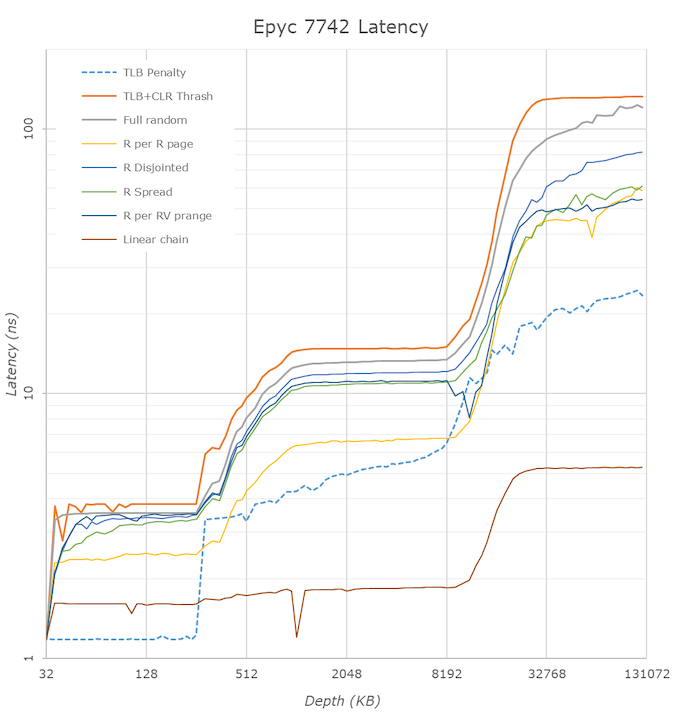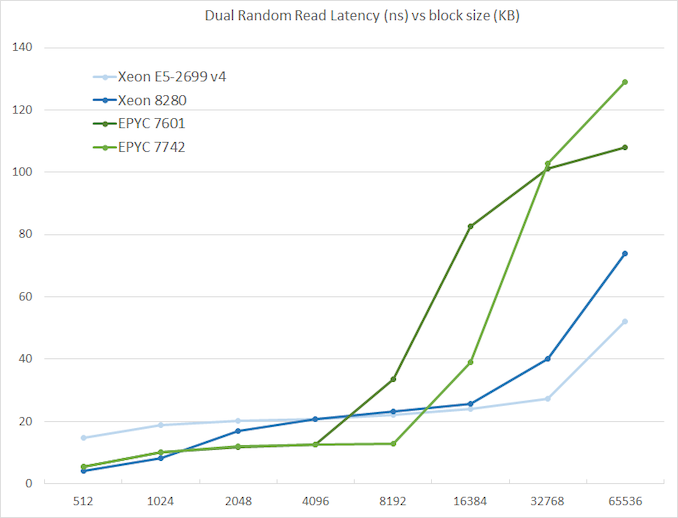AMD Rome Second Generation EPYC Review: 2x 64-core Benchmarked
by Johan De Gelas on August 7, 2019 7:00 PM ESTMemory Subsystem: TinyMemBench
We doublechecked our LMBench numbers with Andrei's custom memory latency test.
The latency tool also measures bandwidth and it became clear than once we move beyond 16 MB, DRAM is accessed. When Andrei compared with our Ryzen 9 3900x numbers, he noted:
The prefetchers on the Rome platform don't look nearly as aggressive as on the Ryzen unit on the L2 and L3
It would appear that parts of the prefetchers are adjusted for Rome compared to Ryzen 3000. In effect, the prefetchers are less aggressive than on the consumer parts, and we believe that AMD has made this choice by the fact that quite a few applications (Java and HPC) suffer a bit if the prefetchers take up too much bandwidth. By making the prefetchers less aggressive in Rome, it could aid performance in those tests.
While we could not retest all our servers with Andrei's memory latency test by the deadline (see the "Murphy's Law" section on page 5), we turned to our open source TinyMemBench benchmark results. The source was compiled for x86 with GCC and the optimization level was set to "-O3". The measurement is described well by the manual of TinyMemBench:
Average time is measured for random memory accesses in the buffers of different sizes. The larger the buffer, the more significant the relative contributions of TLB, L1/L2 cache misses, and DRAM accesses become. All the numbers represent extra time, which needs to be added to L1 cache latency (4 cycles).
We tested with dual random read, as we wanted to see how the memory system coped with multiple read requests.
The graph shows how the larger L3 cache of the EPYC 7742 resulting in a much lower latency between 4 and 16 MB, compared to the EPYC 7601. The L3 cache inside the CCX is also very fast (2-8 MB) compared to Intel's Mesh (8280) and Ring topologies (E5).
However, once we access more than 16 MB, Intel has a clear advantage due to the slower but much larger shared L3 cache. When we tested the new EPYC CPUs in a more advanced NUMA setting (with NPS = 4 setting, meaning 4 nodes per socket), latency at 64 MB lowered from 129 to 119. We quote AMD's engineering:
In NPS4, the NUMA domains are reported to software in such a way as it chiplets always access the near (2 channels) DRAM. In NPS1 the 8ch are hardware-interleaved and there is more latency to get to further ones. It varies by pairs of DRAM channels, with the furthest one being ~20-25ns (depending on the various speeds) further away than the nearest. Generally, the latencies are +~6-8ns, +~8-10ns, +~20-25ns in pairs of channels vs the physically nearest ones."
So that also explains why AMD states that select workloads achieve better performance with NPS = 4.












180 Comments
View All Comments
Cooe - Thursday, August 8, 2019 - link
Hexus got around ≈31,000 iirc.Ryan Smith - Thursday, August 8, 2019 - link
Funny enough, from what I've heard from other people who have tested it, it actually doesn't run all that well with dual EPYCs. Too many cores that are too fast, to the point that initialization times are starting to hold back performance.Ian Cutress - Thursday, August 8, 2019 - link
I got a message from the Cinebench team at one point. They don't spawn/kill/respawn for each little segment: it's kept alive and just fed more data. CB20 is also designed to scale, given that CB15 freaked out above 32 cores or soprisonerX - Wednesday, August 7, 2019 - link
Where is our resident Intel shill? Selling his INTC stock in a panic perhaps?abufrejoval - Wednesday, August 7, 2019 - link
comiserating with the ARM server guysLord of the Bored - Thursday, August 8, 2019 - link
Not gonna lie, I scrolled straight to the comments to see the Intel fanboy spinning this. Instead I got a wall of... Call of Duty references, I think?PeachNCream - Friday, August 9, 2019 - link
The fact that AMD released a product that breaks even HStewart's ability to defend shill for Intel should say something pretty epic about Epyc.Lord of the Bored - Saturday, August 10, 2019 - link
You ain't lyin' there. Seems the name was chosen well.Korguz - Saturday, August 10, 2019 - link
i bet, he would STILL but the intel cpu too. even though it costs more, slower and probably uses more power.Samus - Thursday, August 8, 2019 - link
I was just thinking if Trump doesn't crash the market with his shenanigans then AMD could be an incredibly good buy in the next few months. The first time they've been a good buy in awhile.Although a lot of my daytrader friends have always claimed AMD was a good short-term buy, which is partially true, but if they can keep momentum and Intel doesn't try strongarming them out of OEMs (you know, like they used too...)